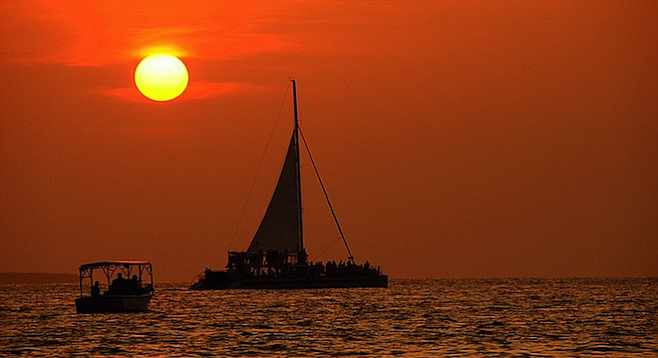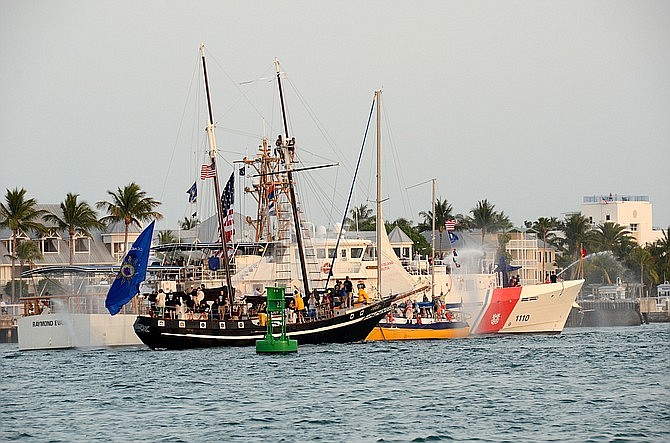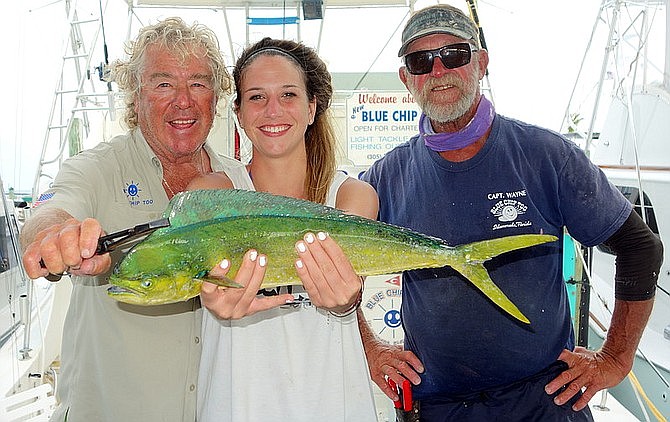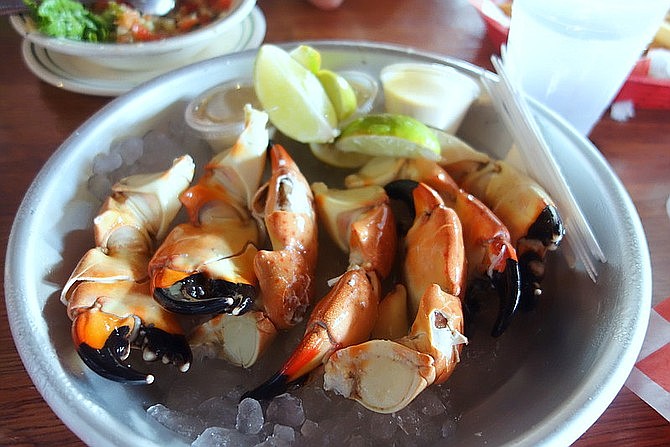 Facebook
Facebook
 X
X
 Instagram
Instagram
 TikTok
TikTok
 Youtube
Youtube

The Florida Keys attract a cast of irreverent, lively characters and denizens – independent folk who embrace the perks of island living. Perhaps that’s why the Keys became the “Conch Republic” in 1982, succeeding with secession where none did before.

The day started out humid and sultry, with few westerly winds to provide relief from the oppressive temperatures – quite unusual for April in the Keys. Word was that a rebellion was brewing: the Keys were gathering flotilla forces to confront the U.S. Coast Guard presence. Helicopters buzzed overhead, while the renegade flagship of the Keys – the topsail schooner Wolf – was prepared with a high-pressure water hose to defend the fledgling republic.
I was onboard the custom-built sloop High Tide, participating in the reenactment of the colorful Great Sea Battle, where bombs are biodegradable rolls of toilet paper and assault weapons consist of stale loves of Cuban bread, oftentimes propelled with the use of a tennis racket.
At one point, a rebel dinghy came precariously close to our vessel, only to surprise and pellet us with scum balls of uncertain origin. I wasn't sure what side they were on (or what side we were on, for that matter). But it was ridiculous fun, so we toasted to our irreverent dinghy, the splendor of a Key West sunset, and brothers-in-arm on both sides.
Though never officially recognized, the Conch Republic sobriquet is still honored, and like so many events in the Keys, it’s become yet another reason for celebration and tourism. Thirty-three years after the separation, you’ll still find many patriots who celebrate their nation's independence day. Events include a 10-day festival and activities like a "drag" race between female impersonators, a good-natured sea battle featuring historic tall ships, and a crazy parade that marches from the Gulf to the Atlantic.

Each April, in conjunction with the annual Conch Republic Independence Celebration, the Great Sea Battle commemorates when the Conch Republic was established by "secession" of the Florida Keys from the United State of America on April 23rd, 1982.
The breakaway republic was conceived in jest to protest the unannounced blockade imposed by the U.S. Border Patrol at Florida City, effectively inspecting all traffic out of the Keys. (Some accounts say the roadblock was conceived to stem illegal drug traffic, while other versions attribute the check station to curtailing the influx of Cuban immigrants from entering mainland United States through the Florida Keys.)
Whatever the cause, a staged ceremonial secession from the mother country followed, along with a symbolic attack on a man dressed in a U.S. Navy uniform using a stale loaf of Cuban bread. After the stale bread assault, officials representing the Conch Republic including Prime Minister Dennis Wardlow (aka Mayor of Key West) immediately surrendered to the Admiral in charge of the Navy Base at Key West – within 60 seconds of the incident, by some accounts. But not before demanding $1 billion in foreign aid and war relief "to rebuild our nation after the long federal siege."
So it was that with a combination of parody and humor that residents of the Florida Keys brought national attention to arbitrary federal actions choking their local economy. What they couldn't affect through the courts they were able to make happen through media and national attention. The result? The U.S. Border Patrol roadblock was removed without any pomp or ceremony.
Today, the Conch Republic has its own flag with the motto, "We Seceded Where Others Failed." And though all residents are dual citizen of both America and the Conch Republic - thus entitled to a Conch Republic passport - even non-citizens can buy a Conch Republic passport for a fee. (The latest price is listed as $100 for the citizen passport).
Though not official, rumor has it that both Citizen and Diplomatic passports have been accepted by over 30 countries, including the United States, Mexico, Germany, Spain, Ireland, Sweden, Russia, Cuba and Ecuador. (Important note to Nigeria: The Conch Republic does not represent their passports as valid travel documents, and they confer no special privilege with regards to United States immigration policies.)
Back to the battle: With our ringside water seat aboard the High Tide, we were lucky to have avoided the dreaded water hose. (Though with the heat, it might have been a welcome relief if we had been doused.)
The rebellion over almost as quickly as it started, we headed for shore with the last rays of twilight. Drink, dance, music and merriment were on order at the Schooner Wharf Bar in Key West's Historic Seaport. Not only would we celebrate victory (and our survival), but also the official “surrender” of the U.S. Border Patrol - or was it the U.S. Coast Guard?

Still confused whether we were victorious or raising the white flag, I guess it really didn't matter in the end. At the Victory Party and Surrender Ceremony, everyone toasted to yet another successful independence celebration.
While in Key West, I also visited the Hemingway Home, where descendants of his favorite six-toed cats prance around the grounds with an aristocratic sanctity. Many visitors arrive at this popular tourist attraction via port visits from their docked cruise ships.

I also took time for a sunset celebration on Mallory Square, an oyster feast, stone crab claws and pink shrimp at the Half Shell Raw Bar, a walk down infamous Duval Street for nightlife, a peak at the Mel Fisher Maritime Museum treasures, and became a detective on Sloan's Ghost Hunt tour, an interactive ghost-hunting foray with renowned ghost hunter and author David Sloan. If you dare, ask him about the cursed "Robert the Doll."
While in Key Largo, I took a canal cruise on the original African Queen, hand-fed hungry tarpon at Robbie's Marina in Islamorada and went fishing for my supper with Capt. Skip Bradeen aboard the Blue Chip Too – later feasting on "Cook our Catch" at Lazy Days Restaurant.
I photographed endangered Key deer in the National Key Deer Refuge on Big Pine Key and had a drink at the No Name Pub. I stopped for lunch on Stock Island at the Hogfish Bar and Grill, savoring the house specialty – what else but hogfish.

Throughout the Keys I dined on specialties of conch fritters, stone crab claws, pink shrimp, hogfish, catch-of-the-day and, of course, Key Lime Pie.
Where else but in the Keys?


The Florida Keys attract a cast of irreverent, lively characters and denizens – independent folk who embrace the perks of island living. Perhaps that’s why the Keys became the “Conch Republic” in 1982, succeeding with secession where none did before.

The day started out humid and sultry, with few westerly winds to provide relief from the oppressive temperatures – quite unusual for April in the Keys. Word was that a rebellion was brewing: the Keys were gathering flotilla forces to confront the U.S. Coast Guard presence. Helicopters buzzed overhead, while the renegade flagship of the Keys – the topsail schooner Wolf – was prepared with a high-pressure water hose to defend the fledgling republic.
I was onboard the custom-built sloop High Tide, participating in the reenactment of the colorful Great Sea Battle, where bombs are biodegradable rolls of toilet paper and assault weapons consist of stale loves of Cuban bread, oftentimes propelled with the use of a tennis racket.
At one point, a rebel dinghy came precariously close to our vessel, only to surprise and pellet us with scum balls of uncertain origin. I wasn't sure what side they were on (or what side we were on, for that matter). But it was ridiculous fun, so we toasted to our irreverent dinghy, the splendor of a Key West sunset, and brothers-in-arm on both sides.
Though never officially recognized, the Conch Republic sobriquet is still honored, and like so many events in the Keys, it’s become yet another reason for celebration and tourism. Thirty-three years after the separation, you’ll still find many patriots who celebrate their nation's independence day. Events include a 10-day festival and activities like a "drag" race between female impersonators, a good-natured sea battle featuring historic tall ships, and a crazy parade that marches from the Gulf to the Atlantic.

Each April, in conjunction with the annual Conch Republic Independence Celebration, the Great Sea Battle commemorates when the Conch Republic was established by "secession" of the Florida Keys from the United State of America on April 23rd, 1982.
The breakaway republic was conceived in jest to protest the unannounced blockade imposed by the U.S. Border Patrol at Florida City, effectively inspecting all traffic out of the Keys. (Some accounts say the roadblock was conceived to stem illegal drug traffic, while other versions attribute the check station to curtailing the influx of Cuban immigrants from entering mainland United States through the Florida Keys.)
Whatever the cause, a staged ceremonial secession from the mother country followed, along with a symbolic attack on a man dressed in a U.S. Navy uniform using a stale loaf of Cuban bread. After the stale bread assault, officials representing the Conch Republic including Prime Minister Dennis Wardlow (aka Mayor of Key West) immediately surrendered to the Admiral in charge of the Navy Base at Key West – within 60 seconds of the incident, by some accounts. But not before demanding $1 billion in foreign aid and war relief "to rebuild our nation after the long federal siege."
So it was that with a combination of parody and humor that residents of the Florida Keys brought national attention to arbitrary federal actions choking their local economy. What they couldn't affect through the courts they were able to make happen through media and national attention. The result? The U.S. Border Patrol roadblock was removed without any pomp or ceremony.
Today, the Conch Republic has its own flag with the motto, "We Seceded Where Others Failed." And though all residents are dual citizen of both America and the Conch Republic - thus entitled to a Conch Republic passport - even non-citizens can buy a Conch Republic passport for a fee. (The latest price is listed as $100 for the citizen passport).
Though not official, rumor has it that both Citizen and Diplomatic passports have been accepted by over 30 countries, including the United States, Mexico, Germany, Spain, Ireland, Sweden, Russia, Cuba and Ecuador. (Important note to Nigeria: The Conch Republic does not represent their passports as valid travel documents, and they confer no special privilege with regards to United States immigration policies.)
Back to the battle: With our ringside water seat aboard the High Tide, we were lucky to have avoided the dreaded water hose. (Though with the heat, it might have been a welcome relief if we had been doused.)
The rebellion over almost as quickly as it started, we headed for shore with the last rays of twilight. Drink, dance, music and merriment were on order at the Schooner Wharf Bar in Key West's Historic Seaport. Not only would we celebrate victory (and our survival), but also the official “surrender” of the U.S. Border Patrol - or was it the U.S. Coast Guard?

Still confused whether we were victorious or raising the white flag, I guess it really didn't matter in the end. At the Victory Party and Surrender Ceremony, everyone toasted to yet another successful independence celebration.
While in Key West, I also visited the Hemingway Home, where descendants of his favorite six-toed cats prance around the grounds with an aristocratic sanctity. Many visitors arrive at this popular tourist attraction via port visits from their docked cruise ships.

I also took time for a sunset celebration on Mallory Square, an oyster feast, stone crab claws and pink shrimp at the Half Shell Raw Bar, a walk down infamous Duval Street for nightlife, a peak at the Mel Fisher Maritime Museum treasures, and became a detective on Sloan's Ghost Hunt tour, an interactive ghost-hunting foray with renowned ghost hunter and author David Sloan. If you dare, ask him about the cursed "Robert the Doll."
While in Key Largo, I took a canal cruise on the original African Queen, hand-fed hungry tarpon at Robbie's Marina in Islamorada and went fishing for my supper with Capt. Skip Bradeen aboard the Blue Chip Too – later feasting on "Cook our Catch" at Lazy Days Restaurant.
I photographed endangered Key deer in the National Key Deer Refuge on Big Pine Key and had a drink at the No Name Pub. I stopped for lunch on Stock Island at the Hogfish Bar and Grill, savoring the house specialty – what else but hogfish.

Throughout the Keys I dined on specialties of conch fritters, stone crab claws, pink shrimp, hogfish, catch-of-the-day and, of course, Key Lime Pie.
Where else but in the Keys?
Comments